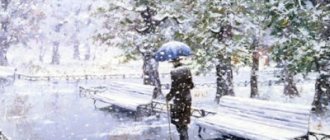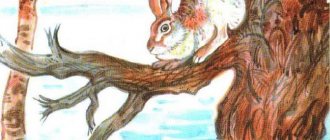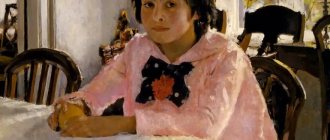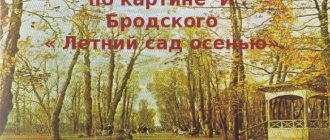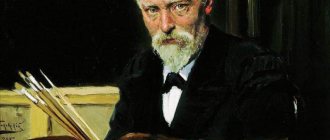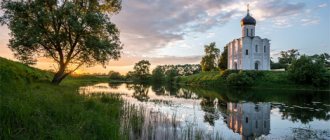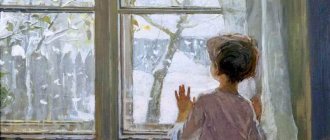Arkady Aleksandrovich Plastov is a Russian artist. Born in the village of Prislonikhe, Ulyanovsk region. Since childhood I loved to draw. He graduated from the Moscow School of Painting in the sculpture department, and studied painting on his own. Plastov loved the village, children, and lived and worked for a long time in his native Prislonikha. The artist wrote many paintings about the life of village children (“Picking mushrooms”, “Shepherd boy”). A.A. Plastov is an artist in love with Russian nature, Russian land, and Russian people.
Let's take a close look at Plastov's painting “First Snow”. In the foreground, on the right, are two children's figures - a girl and a boy. This is brother and sister. They were looking forward to the coming of winter, and then the long-awaited first snow fell, covering the earth with a white blanket. The children's joy was so great that they could not sit at home and, somehow throwing on their clothes, ran out onto the porch.
Look carefully at the expressions on the faces of the girl and boy and try to understand their emotional state. The girl put her smiling face towards the falling snowflakes, and the boy carefully, intently watches them. The artist deeply reveals the characters of village children, emphasizing what unites them in common (closeness to their native nature) and what is distinctive (their different perceptions of one phenomenon).
In the background, our attention is drawn to a birch tree with long thin branches, through which snowflakes flying in the air are visible. A magpie on a branch and a crow in the snow complement and enliven the village landscape. In the depths of the picture, the artist depicts a horse harnessed to a sleigh, a driver, and a barely noticeable sleigh path. These details fill the picture with leisurely movement. In the background, in the gray twilight, village huts are visible.
The whole picture exudes warmth and peace; it is permeated with the artist’s feeling of boundless love for his native land, nature, the working man who creates everything beautiful on earth. The artist conveyed his feeling of a fresh winter day and that special state of nature that occurs at the hour of the first snowfall. Plastov knows the life of the Russian village well, and in his painting he managed to show the rural winter landscape in all its beauty and charm. The artist helped us to experience even more clearly the joyful feeling of delight at the sight of the first snow. With the power of his art, the artist showed a bright and poetic celebration of nature, we feel this celebration. You cannot remain indifferent while looking at this splendor of nature.
The painting “First Snow” reveals the tremulous, pure world of children’s feelings and thoughts. Creating deeply soulful paintings about children, the artist reflected on the fate of an entire generation of Soviet children. After all, the picture was painted in 1946, shortly after the end of the Great Patriotic War. And this joy of peace, the joy of tranquility, this faith in the future fills the picture with a particularly deep meaning. Hence the title of the painting itself - “The First Snow”, which undoubtedly has not only a direct but also a figurative meaning - “The first snow after the war”.
Questions about Plastov’s painting “First Snow”
- What do we see in the foreground of the picture?
- Who do we see on the porch? (A girl of about ten and a boy of about seven are on the porch, they are enjoying the first snow. These are village kids.)
- Why did the children run out onto the porch of their house? (They were very interested in the first snowfall, the children are inquisitive and observant, they are happy about the snow, for them it is a holiday)
- How is the girl dressed? (The girl is without outerwear, she just threw on a scarf. The girl’s felt boots are not the right size, apparently she dressed in a hurry. The children were probably in a hurry. They really wanted to see the first snow as soon as possible.)
- Why does the girl throw her head back and look up? (The guys raise their heads to the sky, look at the snow flakes)
- How is the boy dressed? (the boy is wearing a coat)
- What are they looking at? (Street, white roofs of village huts)
- What do their faces express? With what feeling do they watch the falling snowflakes? (Delight, surprise, happiness, joy, admiration, excitement, interest)
- What time of day did it snow? (Snow fell at night, now it’s morning, the children hastily ran out onto the porch, they haven’t left the house yet)
- What signs of rural life have you noted? How do they help bring the picture to life and make it authentic?
- How are the village huts in the background depicted in the picture?
- Are only children happy about snow?
- Who else do we see in the picture? (To a crow, a magpie on a birch)
- What kind of birds are these? What can you say about the crow, what is it like? (Surprised, important, anxious) What can you say about the magpie? (Snow fell and a magpie flew from the forest closer to the person’s home)
- What else do we see in the picture? (Birch and small shrubs)
- What can you say about the bush? (Snow covered its lower branches and bent it to the ground)
- What can you say about birch, what is it like? (Birch: sleepy, old, tired)
- What is shown in the background of the picture? (Horse harnessed to a sleigh, coachman, village street, white roofs of houses)
- What kind of sky do we see in the picture? (Gray, gloomy, cloudy, gloomy, covered with clouds)
- What can you say about the earth? (White, wrapped in a blanket, spread out the carpet...)
- Describe the snow. (White, loose, fluffy, silver, clean, bright, sparkling)
- Describe the snowflakes. (Look like stars; light as feathers; slowly spinning in the air; like lace...)
- What colors predominate in the picture? How do they help the author reveal the feelings and joyful mood of children? (The whole picture is permeated with a warm, soft light. The colors in it are dim, discreet. White, gray-gloomy tones evoke an emotional response in the viewer’s soul. The artist deeply felt what was depicted on the canvas, and his bright mood is conveyed to the viewer).
- Why did the artist name his painting this way?
- What impression did the picture make on you, what feelings did it evoke in you?
Essay on the topic “First snow”
Cool! 45
As autumn passes, I look forward to the first snowfall. An amazing miracle of nature, like white particles of the sky quietly falling on your shoulders, silently melting away. Delight is what I feel when the first snow comes to my city. Slowly covering everything around. For some reason he often comes at night. You wake up, and he’s right there! Everything is white. Clean, fresh, it sparkles in the morning sun like precious stones. Immediately the air is filled with the unique smell of fresh snow. Some people may not notice it, but it really smells amazing. The smell of approaching winter, cold and blizzards.
The day before, gloomy clouds wandered across the sky. The gray rags seemed to flutter in gusts of wind. The grey, gloomy city was waiting for a miracle. Everything indicated that there would be snow, the first of this year. But I didn’t feel sad in this weather, because I really wanted to see and feel it as soon as possible, my favorite first snow. Raising my head, spinning along with the snowflakes in a white waltz until I feel dizzy and my whole body carelessly plops down into the snow. And it will continue to fall, landing on my satisfied face, slightly pinching with its touch and getting stuck in my eyelashes.
The first snow is an amazing natural phenomenon, in some places even magical. Like white fluff covering roofs, trees, benches and passers-by. Adults are always busy with something, constantly rushing somewhere and often do not notice this snowy splendor. But even a small handful of soft snow consists of a billion small snowflakes. If you look closely, all of them, without exception, have bizarre patterns. They are incredibly beautiful and unique. Just take it in your hand and they will instantly turn into droplets.
As soon as snow falls for the first time, I always rush outside to touch it, walk on it and catch snowflakes with my tongue. My friends and I play snowballs, laughing merrily, starting a mess. We are always so happy about the first snow, it brings us laughter and pleasure. Walking in a quiet park, you can sometimes hear snow falling on dry, fallen leaves. The barely audible rustling touch of snow, as if quietly whispering, reveals the secret of the approaching winter.
One season gives way to another. At this point the first snow appears, marking with its appearance the end of one thing and the beginning of another. Sometimes it happens that very little of the first snow falls, and it quickly melts, leaving dull puddles, exposing the grayness of the autumn city, wet, faceless tree branches. This also makes me a little sad, I want to enjoy the first snow longer.
The appearance of the first snow always means the beginning of winter, which means the approaching holidays and New Year holidays.
The first is that he always reminds us that skating, skiing, slides and snowmen will start soon. The most wonderful time of the year. A lot of good emotions, joy and pleasant impressions! My friends and I will eagerly await the most important winter holiday, thinking about gifts and arguing about whose will be the best. The first snow brings happiness! Update date: 01/12/2019
Essay plan
Before you start writing an essay, you need to make an outline.
1. Introduction (You can start like this: “In A.A. Plastov’s painting I see...” or “The children woke up in the morning and looked out the window...” or “A.A. Plastov is a famous artist of the twentieth century...”)
2. The main part (which is depicted in Plastov’s painting “First Snow”)
- Foreground of the picture. Description of brother and sister.
- Second plan of the picture. Description of birch, magpie, crow, sleigh and horse, etc.
- Background of the picture (huts, sky, earth, snow).
- Paints used in the painting.
3. Conclusion (“In his painting the artist showed...(colors, mood).” My impression of Plastov’s painting “First Snow”)
Or a simpler plan:
1. Introduction 2. The joy of the children 3. The color and mood of the picture 4. My attitude towards the picture
Of course, you can have your own essay plan, but it will still consist of an introduction, body and conclusion.
"First snow"
The first snowflakes appear when no one is expecting them. They quietly descend to the ground and begin to quickly weave their wedding outfit. Every year, this is how the real winter sonata begins - the time when black becomes white and anything can happen.
The first snow changes everything around. It removes dullness and street dirt from the world, giving in return sparkling purity. The rural landscape is especially changing. There are not as many people and cars here as in the city, so all the delights of the first snow remain untouched for a very long time. The earth is covered with a white shroud; it is especially beautiful on sunny days, when bright rays sparkle on the curves of large snowflakes. Houses and trees are covered in white coats and seem to freeze, falling into a deep sleep.
Urban landscapes also have their charms. The first snow captivates passers-by, hiding traces of dull everyday life from view. But they quickly forget about him, since time waits for no one and it is necessary to hurry about one’s business. Only the reflections of street lamps pave the way for the first snow to reach its final stop - the frozen ground.
Essay “First Snow”
Nature freezes, the birds and wind subside, autumn stands guardedly. Leaden, filled clouds have already gathered in the sky. It seems that now the rather annoying rain will begin again. But the air is very cold, and I look out of the window in anticipation of a miracle. The first snow
begins .
Rare snowflakes appear and gently circle in the frozen, windless air. Gradually the snowfall intensifies, and now a solid white veil covers the sky. If you raise your eyes to it, it seems that snowflakes are flying straight at you, this is how winter greets every resident of the city, because it needs to take care of everyone. Soon a white, sparkling blanket will fall on the roofs of houses and garages, completely cover the cars wintering in the yard, and decorate the trees and bushes.
It's good that the first snow fell on the weekend morning. By ten o'clock many children had gathered in the yard. The little ones, under the supervision of their parents, roll snow balls and make different snowmen. Older children are already throwing the first snowballs, but the snow doesn’t stick well and the snowmen turn out to be clumsy, and the snowballs crumble while still in the air.
Everyone is in a hurry to enjoy the beauty of winter, because the first snow does not lie for long; if the winter sun comes out, it will quickly melt the white blanket. But while there it’s nice to admire the winter landscape, which has completely transformed the yard I know. The first snow is still falling and I get dressed, go out into the yard for a walk, I want to go to the park and see how it has changed after the first surprise of winter.
The already melting snow crunches quietly underfoot, the sidewalk seems very clean and elegant. Today is a day off and the wipers will not be able to quickly sweep away the first drifts of snow. But store owners are already sweeping away the snow from the steps, clearing the approaches for customers. A snow-white hat has appeared on the arch in front of the entrance to the park and is in no hurry to fall to the ground.
Sun and winter
The winter sun came out, and under its rays the snow-covered park turned into a fairyland. Asphalt alleys and bicycle paths were completely hidden under the first snow, the autumn slush retreated, and its traces were covered with a snow-white blanket. A light breeze arose, bringing a new wave of snowfall, and the sun disappeared behind snow clouds. At this time, the weather is very changeable, winter competes with autumn, and nature froze in anticipation of the outcome of this duel.
I am leaving the snowy park, in which there are no paths or paths, and the trees are slowly covered with snow. On the way, you can stop by a cozy cafe and drink tea, or go straight home and watch from the window as the entire yard is covered in a snowstorm. Over time, it is no longer possible to distinguish even the outlines of the playground and the snowmen left behind by the kids. Evening is quietly falling on the city, and the first snow
continues to go, winter is in a hurry to wrap everything around in a white blanket of snow until the first frost.
Popular writings
- Essay on the painting Ukrainian Night by Kuindzhi (description)
Kuindzhi’s painting “Ukrainian Night” has incredible mysticism and energy. Well-chosen colors, as well as dark shades of purple, create a somewhat velvety effect. - Essay The Cruelty of War
War is a synonym for destructiveness, decline, injustice. People always die or are seriously injured in battles. Sometimes, as a result of war, pain is caused to such unprotected - There are no bonds holier than comradeship (based on the story by N.V. Gogol Taras Bulba) essay
Taras Bulba’s speech not only shows the relationships in the Zaporozhye Sich, but is also imbued with patriotism, not imposed from the outside, but developed spontaneously.
Mini essay “First Snow” (Var 1)
The first snow can happen not only in December, but also in November. If he walks at night, then when he wakes up in the morning, everyone immediately realizes that snow has fallen. To do this, just look at the window. It immediately becomes noticeable that it is brighter outside than usual. And when we look out the window, we realize with a smile on our faces that winter has come, because everything outside is covered with snow. Of course, he can only lie there for a short time. After all, the air has not cooled down yet, and the sun still gives us its unspent warmth. But, be that as it may, this is a real herald of the winter season, bringing a lot of the most vivid impressions.
And how much joy this snowball brings to the children! They immediately run out into the courtyards with happy faces and a cheerful mood. And the snowy expanse begins for them! Children make big snowmen, sled and ski. They missed these long-awaited games, fun and entertainment so much. It's interesting to watch the kids. They are having fun and don’t feel the cold at all. A happy smile never leaves their flushed faces. But not everyone welcomes this snowfall with enthusiasm. Some people are not yet ready for this phenomenon. It causes a lot of trouble for vehicle drivers. They have to dig their cars out from under the snowdrifts. And in general, after summer and autumn, it’s hard to immediately tune in to the winter road. But, be that as it may, the first snow brings more beautiful and wonderful moments than troubles. The city is covered with a beautiful snow-white blanket. And all this beauty and splendor is simply breathtaking!
And if you add a picture
As already mentioned, in the school curriculum there is an essay on the topic “The First Snow” based on the painting. According to unwritten rules, Plastov’s artistic creation is always subject to description.
To write an essay on a painting, you must:
- Indicate the year the work was created and its author.
- Describe everything that is drawn on the canvas in free form.
- In the final part, you can write what feelings the image on the canvas evokes.
But first, you should study in detail what is depicted in Plastov’s painting. An essay on the topic “The First Snow” on a given topic should be succinct, concise, and focus on the main details.
Detailed essay-description of the painting The First Snow of Plastov, grade 7
In the winter of 1946, the artist painted the magnificent painting “First Snow”.
With one glance at her, an emotion of joy immediately appears. After all, remember yourself as a child. How you waited for that very first snow, and with what incredible speed you ran outside to enjoy it. So in this painting, the artist depicted two children who went outside to admire the beauty.
Since the picture was painted in the post-war year, we understand that these are children of war. They were the ones who saw that terrible bloody war. It’s even scary to imagine what they went through. The children did not have a childhood, because they stood at the machines on an equal footing with adults and provided the army with weapons. Some at that age were at the front. They helped the nurses at the hospital. It’s so good that this horror is over, and children can go out into the street without fear and look at the sky without fear of a fascist attack.
We see that the kids ran out in a hurry. The girl put felt boots on her bare feet. She is dressed in a light white dress, but managed to grab her mother’s shawl. Her gaze is directed high into the sky. There is a smile on your face. The girl experiences a great feeling of joy and delight from the first snow.
Behind her is a boy, he is dressed in trousers, shoes, a warm jacket and a hat. He's not as happy as his sister. But still he went outside to look at the snow. They stand on the porch and catch the snow with their faces.
Near the house itself there is a dilapidated fence that is about to fall apart. And right next to the house there is a tall and long birch tree. Next, the artist depicted a path with ice, and a lonely magpie sitting on it.
And on the horizon two houses are visible. Perhaps this is all that survived from the village after the war.
The good news is that the children survived that terrible war. They can live a new happy life, enjoy the first snow or the first flower. Therefore, you need to appreciate such moments.
An outstanding Russian landscape artist of the late 19th and early 20th centuries, Arkady Aleksandrovich Plastov devoted his entire life to art. His talent was passed on to him by blood from his parents. After all, they were famous icon painters. From a young age, Arkady Alexandrovich was drawn to knowledge. And as soon as he graduated from school, his parents sent him to study in Moscow. There Plastov received an education at the art academy, studying with famous artists of that time. During the time he lived in Moscow, Plastov managed to attend four educational institutions in the city and graduate with honors. Upon completion of his studies, the artist returns to his native village, where he continues his work. After all, that is where his inspiration lay. The master in his works showed simple peasants, portraits of children and the nature of Russia.
